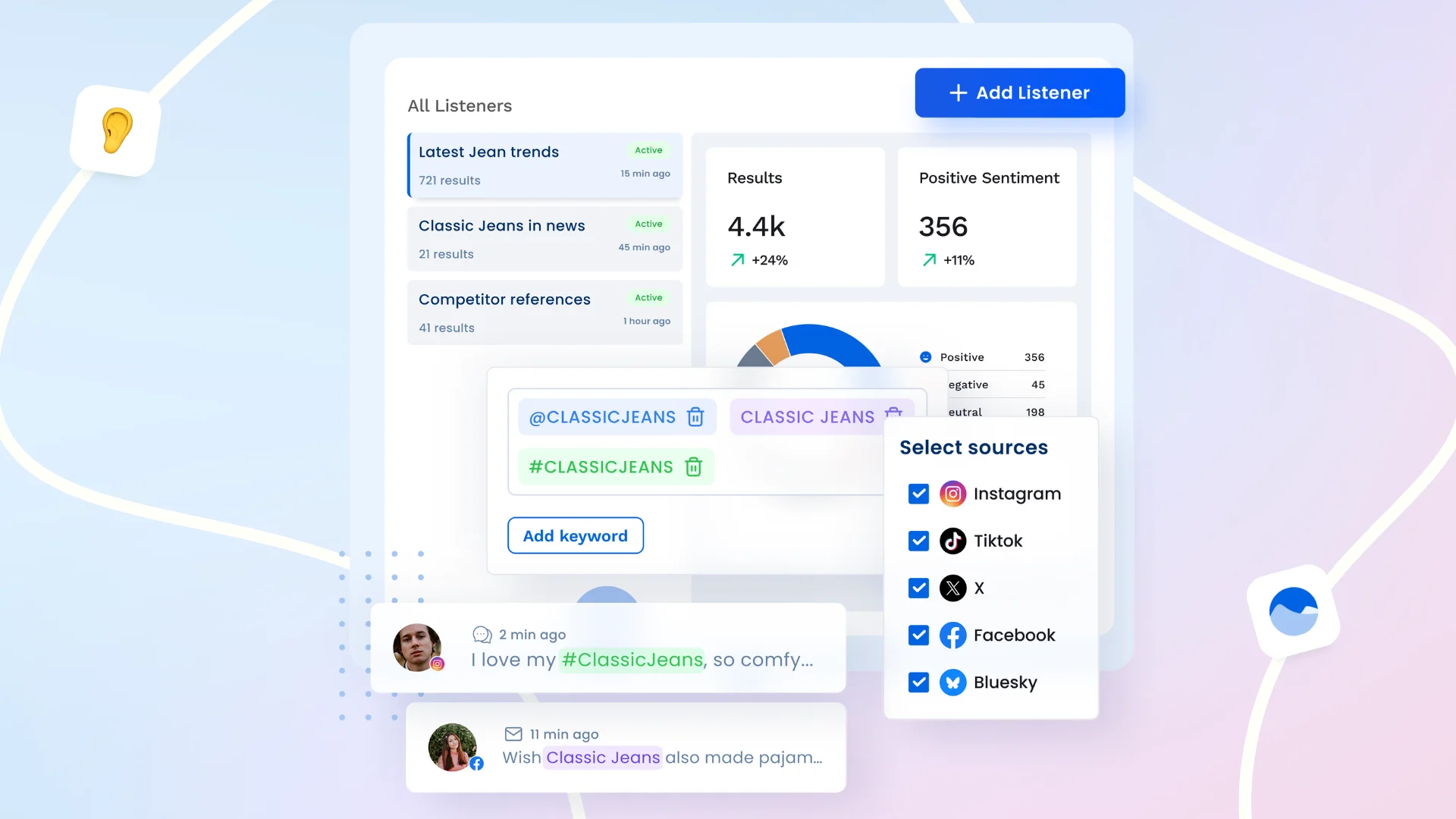New

Social Listening Made Simple: How to Use It for Brand Growth
Learn why social listening is no longer just for big brands and how Vista Social makes it affordable for creators, agencies, and small businesses.

How Something Social Saved 75% of Their Time and Increased Revenue by 15%
See how a fast-growing agency improved operations, cut down hours of manual work, and unlocked new revenue opportunities with Vista Social.
New

50 Unique Social Media Ideas for Consistent Content Creation
Discover 50 unique social media post ideas to engage your audience, grow your brand, and maintain a consistent content strategy with ease!
YouTube Video Size Ultimate Guide: 2025
Updated on June 10, 2025
16 min to read
Content Writer
Published September 13, 2023


Content
Share

Are you experiencing video display issues on YouTube? Are your videos stretched or cropped, or do they have black bars around them? Make those disappear by using the right YouTube Video Size!
And if you want to get more views, engagements, and clicks from your YouTube marketing campaigns, you absolutely need to avoid these display issues since they diminish your audience’s viewing experience.
To help you create YouTube videos without display issues, follow the tips in this guide.
Table of Contents
Essential video-related terminology
What is the best YouTube video size?
How to change the size of a YouTube video?
What’s the best video format for YouTube
Best practices for choosing a YouTube video size
Publish YouTube videos in the right size easily
What are the common issues with YouTube video size?
What are the best practices for compressing YouTube video size without losing quality?
What you can learn about the importance of YouTube video quality from social media marketing leaders
Get your YouTube video sizes right every single time
Table of contents
Essential Video-Related Terminology
Before we dive into the nitty-gritty of the do’s and don’ts of video sizes, let’s first talk about essential video-related terminology.
These words are peppered across the guide and even in most video-related guides you’ll read online.
If you’re reading video-related how-tos, you’re almost 100% guaranteed to run into these words.
Pixels
The word “pixel” is an abbreviation of the phrase “picture element.” Pixels represent the tiniest element within a digital display. They’re super small squares or building blocks that, when put together, form the image shown on a screen, such as texts, graphics, or videos. Videos can have millions of pixels; the more pixels a video has, the higher its resolution.
Resolution
Video resolution is the number of pixels contained in video frames. If a video has a resolution of 2560×1440 pixels, that means the video has a width of 2560 pixels and a height of 1440 pixels. The higher resolution a videos has, the smoother, more detailed, and more realistic its image quality will be.
is the number of pixels contained in video frames. If a video has a resolution of 2560×1440 pixels, that means the video has a width of 2560 pixels and a height of 1440 pixels. The higher resolution a videos has, the smoother, more detailed, and more realistic its image quality will be.
Video frame
A video frame is a still image. When shown one after another in rapid sequence, the human mind views the quick change of frames as a continuous movement, allowing us to watch a video. A great example would be grabbing a notebook, drawing an image on the pages, and then flipping the pages quickly. When the pages are flipped rapidly, the images you drew on the pages appear like they’re moving. The individual pages, in this case, are the video frames.
Frame Per Second (FPS)
In the definition of the video frame above, we talked about the pages of the notebook being flipped quickly. The Frame Per Second (or FPS) is how quickly the pages are flipped.
Aspect ratio
Essentially, the aspect ratio is how a video fits on your device’s screen, whether a TV screen, smartphone, etc. The ratio is often expressed as “X:Y,” where X pertains to the video’s width, and Y is the length. An example aspect ratio would be 9:16. While the numbers are in reference to pixels, the figures themselves are only the ratio of the width and height of the video. After all, 9 px by 16 px would be too small.
Dimensions
The dimension of a video is expressed through its width and height.
The width and height of a video is often measured in pixels. If the video has a width of 640 pixels and a height of 360 pixels, the YouTube video dimensions would be 640 x 360 pixels.
YouTube algorithm
The YouTube algorithm is a recommendation system used by YouTube to determine which videos to show in front of its users. It primarily considers the video’s performance and the user’s watch history.
Bitrate
Bitrate is the amount of video data that is transferred during a specific amount of time. It mainly affects your video’s quality and size and is measured in bits or bits per second.
Video codec
Codecs are computer programs or devices that compress and decompress digital signals and data streams. In video, a codec encodes and decodes video files so viewers can save on internet bandwidth and keep watching high-quality videos.
Video matting
Video matting separates videos into multiple layers, typically the foreground and background, and generates an alpha matte.
The alpha matte determines the blending of the video layers.
Video matting is popular in video editing since it replaces the process layers or background separately.
What Is the Best YouTube Video Size?
A video’s aspect ratio determines its proportion on the screen and ensures it looks professional. It relies on the video’s ratio based on the height and width.
Below are aspect ratio examples:
- 1:1 aspect ratio. This ratio’s main feature is the video’s width and length equality. The 1:1 square aspect ratio is commonly used in social media like Instagram in-feed videos.
- 4:3 aspect ratio. This ratio displays videos as four inches wide and three inches long.
- 16:9 aspect ratio. 16:9 is a common aspect ratio type (known as the widescreen format) is 16 inches wide and 9 inches long. It is the standard aspect ratio used to ensure the best viewing experience.
YouTube’s aspect ratio defaults to 16:9.
These are video dimensions with an aspect ratio of 16:9.
- 1920 x 1080 (Full HD or 1080p)
- 1280 x 720 (HD or 720p)
- 3840 x 2160 (4K Ultra HD)
If your video has a different aspect ratio, YouTube will change it to the ideal size to align with your video and the viewer’s device.
However, in some situations, YouTube will add padding to your video to give the users a better viewing experience.
4k Ultra HD gives your videos the highest resolution of 2160p when recording.
However, while this gives you excellent video quality, it can also take up a lot of phone storage space.
It can also consume a lot of data and require a reliable, strong internet connection when uploading because of the file size.
Lower-quality videos, such as 240p and 360p, display more easily across various devices, including older models.
The catch is that these formats show your videos in poor quality, especially on bigger screen displays, which can ruin the viewing experience.
Your best bet is to use the 1080 resolution since it is high quality enough without consuming too much storage or bandwidth when viewers play your videos.
The 1080 resolution is the video quality gold standard, providing the best video size and quality to viewers regardless of the device or screen size.
How to Change the Size of a YouTube Video?
There’s a myriad of reasons why you need to learn how to change the size of a YouTube video.
For example, if you plan to publish your YouTube video on other social media platforms to get more mileage from each video content you create, you may need to resize it.
YouTube’s aspect ratio defaults to 16:9. But other platforms, such as TikTok, often prefer an aspect ratio of 9:16.
So before you publish your YouTube video on TikTok, it’s a great practice to resize it first so it fits perfectly to TikTok’s preferred 9:16 aspect ratio.
One of the easiest ways to change your YouTube video’s size is to use free online video editors.
Tools like Adobe Express let you resize your videos for YouTube for free.
Upload your video from your device (up to an hour long), enter a custom size, or select YouTube as your destination so the tool automatically adjusts your video to the platform’s default ratio.

Once resized, you can download your video within minutes.
Use similar tools with simple resizing features to get the right YouTube video size quickly.
To change the video’s size when viewing, click the mini player, theater mode, and full-screen options at the bottom-right of the YouTube video player.

You can switch to a higher video resolution by clicking the gear icon and selecting the available options.

Youtube Video Specs
YouTube recommends uploading your videos in the original and high-quality source format to ensure they play at their highest quality.
YouTube’s video formatting guidelines have specifications to ensure the highest quality for videos played on the platform, including the following.
File format
YouTube recommends using the original 1080p HD broadcast format, including the DVD-compliant MPEG-2 (or MPEG-4) program streams saved with a .MPEG extension.
These specifications give optimal playback:
MPEG-2:
- Audio codec – Dolby AC-3 or MPEG Layer II
- Audio bitrate – 128 kbps and up
MPEG-4:
- Video codec – H.264
- Audio codec – AAC
- Audio bitrate 128 kbps and up
Video resolution
YouTube recommends using high-definition videos, generally those with the highest resolution available, to give maximum flexibility for playback and encoding processes.
Videos for rent or sale should have an aspect ratio of 16:9 and a minimum resolution of 1920×1080.
YouTube doesn’t provide a minimum resolution for content with or without ads, but it recommends the following
- Videos with a 16:9 aspect ratio should have a minimum resolution of 1280×720
- Videos with a 4:3 aspect ratio should have a minimum resolution of 640×480
Aspect ratio
Below are the recommended YouTube video aspect ratios:
- A video with a native aspect ratio of 1.77:1 with a total frame size of 1.77:1 should have 16:9 matting without a border and with square pixels.
- A video with a native aspect ratio of 1.77:1 with a total frame size that doesn’t have a 1.77:1 aspect ratio must use 16:9 matting with a single color border with no variations and with square pixels.
- A video with a native aspect ratio and total frame size of 1.33:1 must use a 4:3 matting with no border and with square pixels.
- A video with a native aspect ratio of 1.33:1 with a different frame size aspect ratio should use 4:3 matting with a single-color border with no variations and square pixels.
Video bitrate
YouTube doesn’t recommend a minimum value for bitrate since it is highly dependent on code.
Optimize your videos for frame rate, resolution, and aspect ratio instead of bitrate.
Videos for rental or sale usually have bitrates of 50 or 80Mbps for top quality.
Framerate
Generally, your YouTube videos must be in their native framerates (without resampling) and should be set at 24, 25, or 30 frames per second.
Avoid resampling techniques since these can lower your video’s quality and cause images to shudder.
Film sources should be set at 24fps or 25fps to get the best results.
Check YouTube’s audio file guidelines to ensure high-quality audio tracks for your videos.
What’s the Best Video Format for YouTube
The best YouTube video format is the one that plays your videos at their highest quality.
Stick to YouTube’s recommended format and specs, including the following:
- MP4 (.MP4) format for best high-quality video uploads. .MOV is the second best-recommended format. If your videos are in other formats, consider converting them to .MP4 or .MOV before uploading them to YouTube.
- 15 to 20 MBS
Try Vista Social for Free
A social media management platform that actually helps you grow with easy-to-use content planning, scheduling, engagement and analytics tools.
Get Started NowWhile there are other supported YouTube file formats, try sticking to the top two recommended video formats since others don’t always provide the same audio and quality levels as those two.
Crucial YouTube Guidelines
There’s a lot to remember when ensuring you follow the best and recommended YouTube video sizes, specs, formats, and more.
Here’s a quick summary of the most important YouTube video guidelines you should remember:
- The maximum file size is 128 GB.
- The max video length is 12 hours (720 minutes).
- The maximum video resolution is 2160p with 1080p as the standard high-quality resolution, and the minimum video resolution is 240p.
- The best aspect ratio is 16:9.
- The best video format is .mp4, followed by .mov, but YouTube also supports .avi, .mpeg, .flv, .mpegps, .3GPP, and .webM.
Compress your video file if it exceeds the 128 GB size or 12-hour limit before you upload videos to YouTube.
You must also verify your YouTube brand account before uploading videos that exceed (default) 15 minutes.
Best Practices for Choosing a YouTube Video Size
Consider these tips to nail your YouTube video’s size.
- YouTube supports multiple framerates, including 24, 30, and 60 frames per second, but it’s crucial to use one that doesn’t consume too much data while keeping your video’s quality decent. For instance, 60 fps results in a smoother motion, but it can take more data and isn’t necessary for all content types.
- Stick to the 16:9 aspect ratio for your YouTube videos since it is the most versatile and works well on various tablets, smartphones, and computers.
- Go for a resolution that matches your video’s quality and target audience’s commonly used devices, including smartphones, tablets and connected TVs (CTVs). Your safest bet is to use 1080p to ensure better video quality across various devices. Also, consider using the same resolution for your videos for consistent quality.
- Use the recommended and widely used H.264 (MP4) format. It gives good quality and compression for your videos. It is compatible with many devices and platforms, which is handy if you’re posting your YouTube videos on another social media platform or your website.
- Opt for a bitrate that balances file size and quality without bypassing the YouTube guidelines. Higher bitrates can give your videos higher quality but also make your file sizes larger, so choose accordingly.
- Optimize your YouTube video size for mobile viewers. Use a video size and resolution that look great on smaller screen displays without compromising quality and clarity.
- Ensure your chosen video size doesn’t distort or cut off your YouTube video thumbnail image. Don’t place any important details or elements near the edges of your video’s frame so they don’t get cropped when viewed in smaller device displays.
- Focus on providing an excellent viewing experience to your target audiences. Select a size that keeps your videos high quality while catering to your viewers’ preferred devices.
- Encode your original video using AAc audio at 128kbps or higher for top-quality video audio.
- Consider keeping your YouTube video sizes consistent across your channel. It helps provide your audiences with a more cohesive viewing experience.
- Opt for a video size that complements your content’s lighting and background conditions. High resolution can highlight imperfections within low-quality lighting setups, so choose a video size accordingly.
- If your video has texts, subtitles, and captions, select a video size that ensures everything is readable and clear, especially on smaller screen displays. You can also use text that matches your chosen video size by applying the appropriate font sizes and styles.
- Test your video using various sizes, resolutions, and aspect ratios to see how they display on multiple devices. It helps you spot quality, size, or resolution issues in your videos that you can address and tweak before publishing.
- Track your YouTube video analytics to understand viewers’ behavior and preferences. Stay on top of key metrics such as audience retention, viewer engagement, and watch time to help you refine your YouTube video size choices and improve the viewing experience.
💡Additional tip: Export your video in the highest quality settings your hardware can handle since this provides a good source file when you upload to YouTube.
Tune in to YouTube’s guidelines and documentation since they can change anytime.
Doing so helps you know the latest information on the platform’s recommended video settings and sizes and the best practices, allowing you to tweak your videos accordingly.
Publish YouTube Videos in the Right Size Easily
Planning, creating, scheduling, and publishing your YouTube channel videos in the best size has never been easier with Vista Social.
The platform’s YouTube management tools for business include a suite of essential and advanced features to manage your content, profile, and audience engagement seamlessly.
Vista Social helps you plan, organize, create, and schedule your YouTube posts for auto-publishing with the intuitive publisher and content scheduler.
Connecting your YouTube channel to Vista Social can be done in a few clicks.
Once connected, upload your video to the Vista Social media library and customize your post by adding a description, hashtags, video tags, and more.
Need to create captions for your post quickly? Vista Social’s YouTube caption generator has you covered.
Provide some information about your post, and the tool instantly generates caption options you can choose from.
You can also enable UTM and shortening defaults, include custom parameters, add labels, and set up other post settings.
Once done, you can save your post as a draft, add it to a queue, set an optimal time and date for auto-publishing, or publish the video now.

Need to get that engagement going? Set up Vista Social to auto-generate a first comment and first like.
You can also publish your YouTube Shorts videos through Vista Social.
With efficient content creation and publishing, you can spend more time and energy on ensuring your videos are at their best quality with the right size, resolution, and aspect ratio for YouTube.
Besides the handy publishing and scheduling features, Vista Social offers a collaborative content calendar to simplify your YouTube content development and posting.

You’ll see all your scheduled YouTube posts, including drafts, for the week or month in one place. It makes tracking, reviewing, and managing your content easier.
YouTube publishing with Vista Social is hassle-free and efficient since the platform’s core features help you:
- Search for engaging and timely content from other users on social media to inspire and supplement your posts.
- Post your videos at the best times with the help of optimization algorithms that can automatically schedule your content to publish at times proven to generate audience engagement.
- Keep all your media assets in one place through the platform’s built-in library for easy access and sharing.
- Schedule and manage your YouTube content and profiles on the go with the Vista Social mobile app.
- Append tracking data to your YouTube video links to help you determine social traffic in Google Analytics. It allows you to track your referral traffic, conversions, and campaigns from your YouTube posts.
- Track, measure, analyze, and extract insights from your YouTube content’s performance with Vista Social’s rich analytics features.
- Manage your YouTube channel subscriber comments, likes, shares, and mentions efficiently from a central location so you don’t miss engagement opportunities.
Vista Social has everything you need to streamline and supercharge your YouTube-related tasks and other social media management workflows.
What are the common issues with YouTube video size?
Below are several potential challenges with YouTube video sizes and how you can fix them.
Common issue 1: Distorted images
Images within your clients’ YouTube videos can get distorted with incorrect aspect ratios.
Ensure your clients’ YouTube videos are created in the platform’s recommended 16:19 aspect ratio (9:16 for YouTube Shorts).
Double-check that the settings match the recommended ratios when exporting to prevent further squishing, stretching, and other distortions.
If using older footage, consider cropping the video or adding background elements to ensure it fits the 16:9 frame properly.
Common issue 2: Black bars
Black bars usually appear when your clients’ video dimensions don’t match the YouTube recommended aspect ratio (16:9).
Resizing your video can fix the issue.
You can use reliable video editing tools to adjust your frame size.
Remember to set your export settings to the right aspect ratio: 16:9 and 1920×1080 pixels for high-definition videos.
Common issue 3: Low quality playback
Videos recorded or uploaded in low resolutions can cause poor-quality playbacks.
To prevent this, ensure high-quality settings and use modern codecs such as H.264 when exporting your clients’ YouTube videos.
The codec can balance media file size and quality, ensuring high-quality playback.
Also, ensure you have a strong and stable internet connection when uploading since interruptions can cause video quality issues.
Common issue 4: File size limitations
YouTube has a maximum file size limit for uploading videos.
If your clients’ videos exceed the limit, they may not upload properly or at all.
The key is to compress your clients’ videos using video editing apps and ensure their sizes are within YouTube’s limits without compromising the quality.
Common issue 5: Incompatible formats
YouTube supports specific types of video formats, such as MOV and MP4.
To avoid video size and quality issues, ensure your clients’ videos are in compatible formats before uploading.
If your clients’ videos are in unsupported formats, you can use video converter tools to convert them quickly and easily.
What are the best practices for compressing YouTube video size without losing quality?
Check out the tried-and-tested tips below to help you compress your clients’ YouTube videos while maintaining their quality.
Adjust the video resolution
Consider lowering the video resolution slightly if the original resolution is higher than necessary.
If your client’s video is recorded in high resolution, like 4k, and they don’t need that level of detail, consider reducing the resolution to 720p or 1080p.
Doing so can significantly reduce the video’s file size while providing top quality for many viewing purposes.
For instance, most viewers may not see a huge difference between 1080p and 4k on smartphones or tablets.
Adjusting the resolution can make the video more manageable file size-wise without compromising its’ quality too much.
Take out unnecessary audio channels
If your clients’ YouTube videos don’t need stereo sound, consider using mono to reduce their file sizes.
Stereo audio consumes more space, making mono a better choice to reduce the video’s file size.
Switching from stereo to mono audio can be useful for videos with lots of talking, such as vlogs or tutorials since the difference between the two audio types is less noticeable.
Trim the content
You can reduce your video’s overall file size by removing unnecessary parts, such as long intros, pauses, and transitions.
Trimming down your client’s content can reduce the video’s file size while keeping the content concise and engaging for audiences.
Use video editing platforms that let you cut and join video segments seamlessly.
Following best practices helps you properly compress your clients’ YouTube videos to ensure optimal file size and quality.
Remember, maintaining top video quality ensures a better viewing experience for your clients’ audiences, boosting engagement, subscriptions, and conversions.
What you can learn about the importance of YouTube video quality from social media marketing leaders
Nailing YouTube video sizes is crucial to creating engaging and high-converting content for your clients.
Check out the following content and resources about YouTube videos from popular social media marketing leaders and influencers.
These cover the importance of YouTube videos, effective video marketing strategies, and why you should prioritize quality in video marketing and content.
- Video Content: You’re Doing It Wrong by Gary Vaynerchuk
- Extracting Even More Value from YouTube by Chris Brogan
- YouTube Marketing Strategies: 19 Tips to Grow Your Channel by Neil Patel
- Doing Video Marketing by Jeff Bullas
- How Video Content Marketing Can Learn From Good Writing by Ann Handley
- 7 Reasons Your Business Should Be Using YouTube by Kim Gars
FAQs on YouTube Video Size
Check out the common questions people ask about YouTube video sizes.
What is the standard YouTube video size?
The smallest dimensions of YouTube videos are 426×240 pixels, and the largest dimensions are 3840×2160 pixels.
The standard YouTube video aspect ratio is 16:9.
What video size do creators normally use?
Full HD, 1080 (1920 x 1080 pixels), is the industry standard for crisp and clear HD digital video that won’t consume too much of your storage space.
It’s also the typical screen resolution for most smartphones.
What size are YouTube Shorts?
YouTube Shorts are 60-seconds long or a combination of 15-second videos. Shorts must be in vertical format with a 1920 x 1080 pixels resolution and a 9:16 aspect ratio.
Get Your YouTube Video Sizes Right Every Single Time
Understanding the ins and outs of YouTube video sizes and knowing the best ones to use are crucial to your video’s quality.
Be mindful of your YouTube video size, aspect ratio, resolution, and more, to ensure your videos display at their best quality, providing an excellent viewing experience to your target audience.
Follow best practices, stick to YouTube’s recommendations, and stay updated with the latest information to provide top-quality videos.
P.S. If you’re new here, Vista Social is a comprehensive social media management platform designed for marketing agencies, freelancers, and social media managers. We offer advanced features to improve collaboration, efficiency, and effectiveness in social media marketing.
Create your Vista Social account now to explore our tools and enhance your social media strategy today!
About the Author
Content Writer
Jimmy Rodela is a social media and content marketing consultant with over 9 years of experience, with work appearing on sites such as Business.com, Yahoo, SEMRush, and SearchEnginePeople. He specializes in social media, content marketing, SaaS, small business strategy, marketing automation, and content development.
Never Miss a Trend
Our newsletter is packed with the hottest posts and latest news in social media.

You have many things to do.
Let us help you with social media.
Use our free plan to build momentum for your social media presence.
Or skip ahead and try our paid plan to scale your social media efforts.
P.S. It will be a piece of cake 🍰 with Vista Social
Subscribe to our Newsletter!
to stay updated on the latest and greatest Social Media news
We promise not to spam you!


